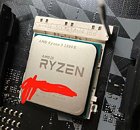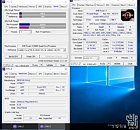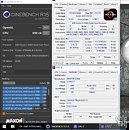Monday, July 2nd 2018

First Benchmarks, Photo of AMD's Ryzen 3 2300X Surface
As AMD is moving closer towards completing its staggered Ryzen 2000 series' launch, first benchmarks and silicon photos have surfaced. AMD's Ryzen 3 2300X is a quad-core solution that leverages the Zen+ architecture on the 12 nm process, improving performance and power consumption over the original Ryzen 3 1300X. Alongside the new CPU line, AMD is also expected to refresh its chipset offerings, with a revised B450 superseding the B350 chipset - though users can drop in their Ryzen 2000 series processors on 300-series chipsets, provided they have the adequate BIOS already installed.
The Ryzen 3 2300X, paired with a BIOSTAR X370 motherboard, was put through its paces under CPU-Z (where it scored 509 and 2020 points in the single and multi-thread benchmarks respectively), as well as in Cinebench (where it scored 690 points). The 2300X can seemingly boost up to 4.2 GHz without any manual overclocking from its 3.5 GHz base clock - an improvement of around 500 MHz in the XFR-enabled boost over its predecessor, which only hit 3.7 GHz.The overall value proposition of this 2300X CPU is somewhat marred, though, by the existence of the 2200G APU - a quad-core solution as well, which also packs in integrated Vega 8 graphics - for $99. And it's unlikely the Ryzen 3 2300X will be priced much lower than the $125 AMD was asking for its 1300X processor, which already looked bad compared to the 2200G. It seems AMD has a missed opportunity in its hands to further differentiate these two product lines by enabling SMT on one of them. If anything, I'd suggest doing so on the APU side of the equation - thus strengthening AMD's performance compared to Intel's i3 CPUs, which all pack integrated graphics, but lack any sort of SMT support.
Sources:
via Videocardz, ChipHell
The Ryzen 3 2300X, paired with a BIOSTAR X370 motherboard, was put through its paces under CPU-Z (where it scored 509 and 2020 points in the single and multi-thread benchmarks respectively), as well as in Cinebench (where it scored 690 points). The 2300X can seemingly boost up to 4.2 GHz without any manual overclocking from its 3.5 GHz base clock - an improvement of around 500 MHz in the XFR-enabled boost over its predecessor, which only hit 3.7 GHz.The overall value proposition of this 2300X CPU is somewhat marred, though, by the existence of the 2200G APU - a quad-core solution as well, which also packs in integrated Vega 8 graphics - for $99. And it's unlikely the Ryzen 3 2300X will be priced much lower than the $125 AMD was asking for its 1300X processor, which already looked bad compared to the 2200G. It seems AMD has a missed opportunity in its hands to further differentiate these two product lines by enabling SMT on one of them. If anything, I'd suggest doing so on the APU side of the equation - thus strengthening AMD's performance compared to Intel's i3 CPUs, which all pack integrated graphics, but lack any sort of SMT support.




21 Comments on First Benchmarks, Photo of AMD's Ryzen 3 2300X Surface
Intel needs to worry
The TDP is The cpu base clock, not The boost freq.
Ryzen 1*** 2017, Ryzen+ 2***, 2018, Ryzen2 3*** 2019, Ryzen2+ 4*** 2020(Tentative), Ryzen 3 5*** 2021...
The 2200G is still a better deal, thanks to what a 1030 costs right now.
Unless of course Intel pulls something out of their behinds in the next couple of months. Nah... I doubt it.
This thing beats out my old i5-3570K at stock speeds.
I'm glad I sold it and upgraded.